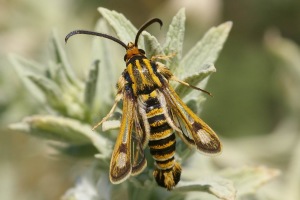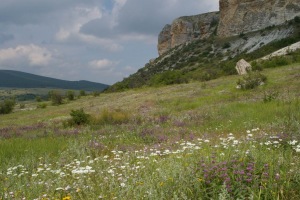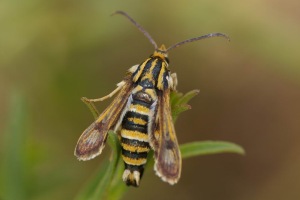

 +6Kontinente:EU
+6Kontinente:EU2. Biologie
2.1. Habitat
2.2. Nahrung der Raupe
- [Lamiaceae:] Marrubium peregrinum (Ungarischer Andorn)
- [Lamiaceae:] Marrubium praecox (Frühblühender Andorn)
Laštůvka (1983) nennt für Chamaesphecia oxybeliformis - nach der erfolgreichen Zucht eines Weibchens aus Bulgarien - Marrubium peregrinum als Nahrungspflanze der Raupe jener Art. Nach Gorbunov (2019) bezieht sich diese Angabe aber nicht auf jenen Falter sensu Herrich-Schäffer, [1846], sondern auf ein damals noch unbeschriebenes Taxon, das er selbst als C. efetovi neu beschreibt. Er selbst züchtete C. efetovi ebenfalls mehrfach und mit Raupenfunden aus verschiedenen Regionen (Krim, Nordkaukasus, Wolgograd Region) aus Marrubium peregrinum und dem nahe verwandten - und oft als Synonym angesehenen - Marrubium praecox.
3. Weitere Informationen
3.1. Etymologie (Namenserklärung)
Gorbunov (2019) erläutert seine Namenswahl: "This new species is named in honour of my friend Prof. Dr. Konstantin A. Efetov (Crimean Federal University, Simferopol’, Russia), a researcher of the Lepidoptera of the Crimean Peninsula and a specialist in the family Zygaenidae of the world fauna." Die meisten Tiere der Paratypen-Serie wurden von Gorbunov und Efetov gemeinsam gesammelt.
3.2. Taxonomie
Nach Gorbunov (2019) wurde Chamaesphecia oxybeliformis bisher fast durchweg fehlinterpretiert. Jene Art ist als Raupe ganz an Phlomis herba-venti ssp. pungens gebunden. Nach Festlegung eines Neotypus für C. oxybeliformis war für die Tiere aus Marrubium peregrinum, die bisher auch unter diesem Namen geführt wurden, eine Neubeschreibung erforderlich: Chamaesphecia efetovi. Nach Gorbunov (2019) scheint Chamaesphecia dumonti die nächstverwandte Art zu sein.
3.3. Faunistik
Der Locus typicus liegt auf der Krim. Gorbunov (2019: 451) schreibt zur Verbreitung: "At present, this new species is known from a lot of localities in Crimea, North Caucasus and Volgograd Region (see material). In addition, references to the whereabouts of Ch. oxybeliformis in Bulgaria [Laštůvka, 1983] and Romania [Popesku-Gorj et al., 1958] should refer to this new species." Efetov et al. (2025) wiesen die Art mit Hilfe von "sex attractants" in der Krasnodar-Region im russischen Nordkaukasus nach.
3.4. Typenmaterial
Gorbunov (2019) schreibt: "Holotype ♂ (Figs 17–18) with labels: “Russia, Crimea, 2.8 km NW / Kurskoye, Bor-Kaya, / 45°03.150´N, 034°55.186´E, / 177 m, 07.VII.2016, / O. Gorbunov & K. Efetov leg.” (white); “SESIIDAE / Pictures №№ / 0303-0304–2016 / Photo by O. Gorbunov” (white); “HOLOTYPUS ♂ / Chamaesphecia efetovi / O. Gorbunov, 2019 / O. Gorbunov des., 2017” (red) (COGM)."
Die sehr lange Liste an Paratypen (141 ♂♂, 13 ♀♀) stammt von diversen Fundorten der Krim, vom Nordkaukasus und von der Wolgograd-Region in Russland.
(Autor: Erwin Rennwald)
3.5. Literatur
- Efetov, K. A., Can, F., Akar, S., Ruchko, P. V. & O. G. Gorbunov (2024): First records of Chamaesphecia efetovi O. Gorbunov, 2019 (Lepidoptera: Sesiidae)in Türkiye (Turkey). — Ecologica Montenegrina 78: 243-251. [PDF auf biotaxa.org]
- Efetov, K. A. & O. G. Gorbunov (2021): New data on distribution of Chamaesphecia efetovi O. Gorbunov, 2019, in the Crimea (Lepidoptera: Sesiidae). — SHILAP Revista de lepidopterología 49 (195): 471-478. [PDF auf redalyc.org]
- Efetov, K.A., Shchurov, V.I. & O.G. Gorbunov (2025): First records of Chamaesphecia efetovi O. Gorbunov, 2019, in Krasnodar Territory (Northern Caucasus, Russia) (Lepidoptera: Sesiidae). — SHILAP Revista de lepidopterología, 53 (209): 139-146. [zum PDF-Download auf shilap.org]
- Erstbeschreibung: Gorbunov, O. G. (2019): Two new species of the genus Chamaesphecia Spuler, 1910 (Lepidoptera: Sesiidae), with remarks on the genus. — Russian Entomological Journal 28 (4): 437–457. doi: 10.15298/rusentj.28.4.13.
- Laštůvka, Z. (1983): Two new species of the genus Chamaesphecia Spul. (Sesiidae) from Central and South East Europe. — Acta universitatis agriculturae facultas agronomica 31 (1-2): 199-214. Brno.









